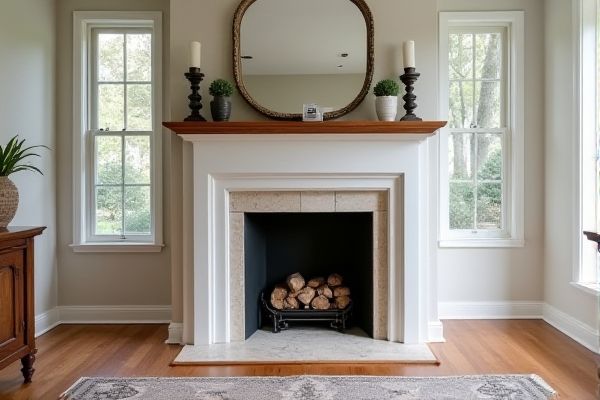
Traditional mantels provide a classic, sturdy framework often crafted from wood or stone, serving as a focal point with built-in shelves or supports, while floating mantels offer a sleek, minimalist look mounted directly to the wall without visible brackets. Understanding the differences can help you choose the best style for Your living space; continue reading to explore the pros and cons of each mantel type.
Table of Comparison
| Feature | Traditional Mantel | Floating Mantel |
|---|---|---|
| Design | Built-in, attached to the wall with supporting brackets | Wall-mounted, appears suspended without visible supports |
| Installation | Requires framing and structural support | Uses strong anchors for secure mounting |
| Style | Classic, ornate, traditional aesthetic | Modern, sleek, minimalist look |
| Space Usage | Protrudes further, can take more room | Compact, saves floor space |
| Maintenance | May require more cleaning due to intricate details | Easy to clean with flat surfaces |
| Material Options | Wood, stone, brick, plaster | Wood, metal, reclaimed materials |
| Cost | Generally higher due to complexity | Typically more affordable and DIY-friendly |
Introduction to Mantels: Traditional vs Floating
Traditional mantels are characterized by their sturdy, built-in construction, often made from wood or stone, and anchored firmly to the wall, providing a classic, timeless aesthetic. Floating mantels offer a modern alternative with a sleek, minimalist design that appears to "float" without visible brackets, ideal for contemporary interiors. Choosing the right mantel for your space depends on your style preference, room architecture, and desired focal point.
Aesthetic Differences Between Traditional and Floating Mantels
Traditional mantels feature ornate detailing and robust profiles that evoke classic, timeless elegance, often crafted from rich wood or stone materials. Floating mantels offer a minimalist, sleek appearance with clean lines, appearing to hover on the wall without visible supports, enhancing modern and contemporary interiors. The key aesthetic difference lies in traditional mantels' elaborate craftsmanship versus floating mantels' streamlined simplicity, catering to distinct design preferences.
Material Choices for Traditional and Floating Mantels
Traditional mantels often showcase rich materials like solid wood, stone, or brick, lending a classic, sturdy appearance that complements rustic and historic interiors. Floating mantels typically use lighter materials such as engineered wood, MDF, or metal to achieve a sleek, minimalist design while maintaining durability and ease of installation. Your choice between traditional and floating mantel materials depends on the desired aesthetic, weight capacity, and maintenance preferences for your living space.
Installation Process: Traditional Mantel vs Floating Mantel
Traditional mantel installation requires securing a heavy wood or stone structure directly to the wall studs, often involving nails, screws, and shims for leveling, which can be time-consuming and may need professional help. Floating mantel installation utilizes hidden brackets mounted to wall studs that support a lighter shelf, enabling quicker setup and a clean, modern look without bulk. The floating option typically demands precise bracket placement for stability, whereas traditional mantels focus on cumulative weight distribution through multiple fastening points.
Cost Comparison: Traditional vs Floating Mantels
Traditional mantels typically cost between $500 and $2,000, influenced by materials such as wood or stone and detailed craftsmanship. Floating mantels, often ranging from $150 to $600, tend to be more affordable due to simpler installation and modern designs using lighter materials like MDF or reclaimed wood. Labor costs for traditional mantels are higher, requiring professional carpentry, whereas floating mantels can often be installed by DIY enthusiasts, further reducing total expenses.
Space and Room Design Considerations
Traditional mantels are bulkier and require more wall space, making them ideal for spacious rooms with classic or ornate designs. Floating mantels save floor space and create a sleek, modern look, perfect for smaller rooms or minimalist interiors. Your choice affects not only the room's aesthetics but also how furniture and decor are arranged around the fireplace.
Durability and Maintenance Factors
Traditional mantels, typically crafted from solid wood or stone, offer superior durability and can withstand daily wear with minimal maintenance, often requiring only occasional polishing or sealing to maintain their appearance. Floating mantels, usually made from engineered wood or lightweight materials, may require more frequent upkeep to prevent scratches and ensure secure mounting, especially in high-traffic areas. Your choice between the two should consider the balance between long-term durability and the ease of routine maintenance in your living space.
Style Compatibility with Home Decor
Traditional mantels, often featuring ornate woodwork and classic designs, complement homes with vintage, rustic, or colonial-style decor, enhancing a warm and timeless atmosphere. Floating mantels, characterized by sleek lines and minimalistic profiles, integrate seamlessly into modern, contemporary, or industrial interiors, providing a clean and unobtrusive focal point. Both mantel types serve as versatile elements that can elevate the overall aesthetic by matching the home's architectural and decorative themes.
Pros and Cons of Traditional Mantels
Traditional mantels offer a classic, sturdy design often made from wood or stone, providing a timeless architectural focal point that enhances your room's ambiance. Their solid construction allows for ample display space and durability, but they typically require professional installation and take up more wall space, limiting flexibility in room layout. While traditional mantels add historical charm and warmth, they may not suit modern minimalist aesthetics and can be more costly compared to floating mantel options.
Pros and Cons of Floating Mantels
Floating mantels offer a sleek, modern aesthetic that maximizes wall space and creates a minimalist focal point in living rooms. They are easier to install compared to traditional mantels, often requiring only wall anchors, but may lack the structural support needed for heavy decor or large fireplaces. While floating mantels enhance contemporary interior designs, traditional mantels provide more customization options and durability with built-in shelving or mantelpieces.
 homyna.com
homyna.com